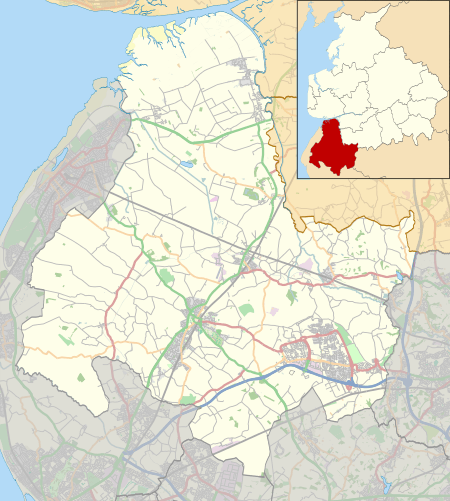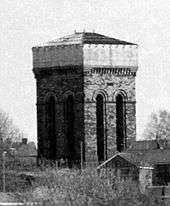Tower Hill Water Tower
Tower Hill Water Tower is a disused water tower and local landmark in Ormskirk, Lancashire, England. Situated on the east side of Tower Hill, it was built between 1853-4 for Ormskirk Local Board of Health,[1] and is reputed to be the oldest remaining water tower in the country.[2] It was awarded Grade II* listed status in 1976,[1] and is on the Heritage at Risk Register.[3] The area immediately surrounding the tower has been used as allotments since the mid 20th century.[4]
| Tower Hill Water Tower | |
|---|---|
The water tower in 2015 | |
 Location within the Borough of West Lancashire | |
| General information | |
| Type | Water tower |
| Architectural style | Romanesque Revival |
| Location | Ormskirk, Lancashire |
| Country | England |
| Coordinates | 53.56954°N 2.87242°W |
| Construction started | 1853 |
| Completed | 1854 |
| Client | Ormskirk Local Board of Health |
| Height | 17 m (56 ft) |
Listed Building – Grade II* | |
| Official name | Water tower on Tower Hill |
| Designated | 22 March 1976 |
| Reference no. | 1197069[1] |
Structure
The tower is built in the Romanesque Revival style, constructed of coursed, squared sandstone, and arranged in a square plan. On each side are two narrow full-height Romanesque arches, all with stepped surrounds and arch-bands, and linked by an impost band. Above the arches is a plain frieze with carved grotesques at the corners, topped with machicolated corbelling.[1][5] The stone is a pale red and mottled form of Ormskirk Sandstone, probably extracted from nearby Ruff Wood.[6]
In its present state, the tower stands at a height of approximately 17 metres (56 ft). Originally, the stonework was surmounted by a metal water tank with a pitched slate-covered roof, which added an extra 6.2 metres (20 ft) to the height of the structure. Due to its poor condition, the tank was removed in the early 1990s.[2]
Proposed developments
Planning permission was granted in 1988 for the conversion of the tower into a single dwelling, though the scheme was never implemented. Subsequent applications to convert the tower into offices or an apartment block were either refused or withdrawn.[2] A more recent application for conversion into seven apartments was made in 2004, though this has also been rejected,[2][7] and an appeal against the decision was dismissed in April 2008.[8]
Development of the site has met with opposition from local residents,[2][4] and local Conservative councillor Adrian Owens was amongst critics of the most recent application.[7][9]
See also
- Grade II* listed buildings in Lancashire
- Listed buildings in Ormskirk
- Jumbo Water Tower, a water tower of similar design in Colchester, Essex

References
- Historic England. "Water Tower on Tower Hill (1197069)". National Heritage List for England. Retrieved 16 May 2015.
- "Planning Permission Application No. 8/2004/1644 and Listed Building Consent Application No. 8/2004/1645". West Lancashire District Council. Retrieved 29 July 2008.
- Historic England. "Water Tower, Tower Hill, Ormskirk - West Lancashire". Heritage at Risk Register. Retrieved 16 May 2015.
- James, Henry (30 January 2008). "Battle to save allotments". Champion. Retrieved 16 May 2015.
- Pollard, Richard; Pevsner, Nikolaus; Sharples, Joseph (2006). Lancashire: Liverpool and the Southwest. Yale University Press. p. 535. ISBN 0-300-10910-5. Retrieved 29 July 2008.
- English Heritage (December 2011). "Strategic Stone Study: A Building Stone Atlas of Lancashire" (PDF). British Geological Survey. p. 15. Retrieved 16 May 2015.
- "Planning Rejection first step to a better heritage landmark". Adrian Owens. 29 July 2007. Archived from the original on 13 March 2012. Retrieved 29 July 2008.
- "Ormskirk water tower plan appeal is rejected". Ormskirk and Skelmersdale Advertiser. 7 May 2008. Retrieved 16 May 2015.
- "Consign Water Tower Plan to Reject Bin". Adrian Owens. 27 February 2007. Archived from the original on 13 March 2012. Retrieved 29 July 2008.
External links

